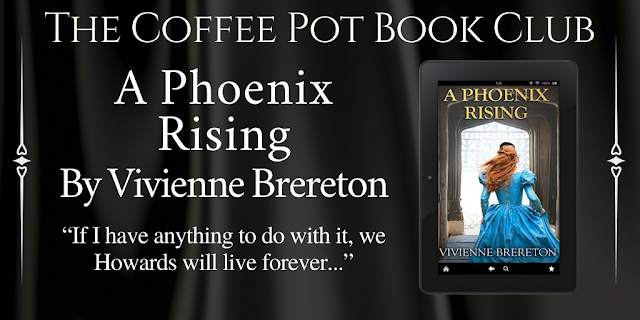A Phoenix Rising
Publisher: Yuletide Press
Page Length: 374 Pages
Genre: Historical Fiction
The Howards have it all! Wealth, power, brains and beauty. Not to mention, physical prowess, charm in abundance, and the favour of a king. But then the unthinkable happens. They lose everything overnight. In a catastrophic reversal of fortune. How?
1485. Bosworth Field. Loyally backing a Yorkist king over a Tudor usurper (who wins the day) costs the family very dear. The head of the Howards is killed alongside his king, while his disgraced son is flung into the Tower for three long years.
Meet Thomas Howard, Earl of Surrey. Proud father of three strong sons, two beautiful daughters, and grandfather to two of Henry VIII’s future wives. Soldier. Statesman. Courtier. Keeper of secrets hidden behind castle walls. Heady places of intrigue and lovers’ trysts.
Once freed, Thomas vows to regain his position at the prosperous court of Henry VII, like a phoenix rising from the ashes. And restore the Howard family, formerly one of the most powerful in England, to its former glory.
“If I have anything to do with it, we Howards will live forever.”
The magnificent royal courts of Europe provide a sensual backdrop for innocent first love and passionate love affairs, alongside arranged noble marriages. Meanwhile, hidden danger, revenge, and ruthless ambition stalk the candlelit corridors.
Be dazzled by the dancing, drama and display in Tudor England, Stewart Scotland, Valois France, and The Habsburg Empire. Feast in the great halls and enjoy the delicious fare. (Recipes included!) Many names will be familiar: Katherine of Aragon, Thomas Wolsey, Anne and Mary Boleyn, Charles Brandon and Thomas More. Some less so: Louis XII and François de Valois of France.
Plans are equally likely to be drawn up for a bloody war, as for an extraordinary event such as the fabled 1520 Field of Cloth of Gold.
1509. After their calamitous period of disgrace, the Howards are once more riding high at the glittering court of a young Henry VIII due to Thomas’s intelligence and perseverance, and the part played by his middle son, Edward, a royal favourite known for his pleasing appearance, swagger and daring.
Thomas’s travels take him down to Cornwall, up to Scotland, and across the Narrow Sea separating England from France. Mystery swirls around the lives of four young people: Tristan, Cecily, Valentine, and Nicolas.
But there are no secrets that time does not reveal….
US Boys 2019 | US Girls 2019 | UK Boys 2019 | UK Girls 2019 | Tudor England Boys 1519 | Tudor England Girls 1519 | |
1 | Liam | Olivia | Muhammad | Olivia | John | Mary/Marie |
2 | Noah | Emma | Noah | Sophia | Thomas | Elizabeth |
3 | Elijah | Ava | George | Lily | William | Jone/Jane/Joan |
4 | Oliver | Sophia | Oliver | Ava | Richard | Margaret/Margery |
5 | Lucas | Isabella | Charlie | Mia | Henry | Ann/Anne |
6 | Mason | Amelia | Harry | Isla | Edward | Agnes |
7 | Ethan | Mia | Leo | Amelia | Ralf/Ralff | Alice/Alis |
8 | Logan | Charlotte | Arthur | Freya | George | Joanna/Johanna |
9 | Aiden | Harper | Jack | Isabella | Robert | Susan |
10 | James | Luna | Freddie | Emily | Humfrey | Annis |
 |
| Henry VII Henry VIII |
Thomas Wolsey.
Born between historic Winchester and Southampton in the UK, I have been passionate about the Tudors for as long as I can remember. This led to a degree in Medieval History at university, and the growing desire to write a novel.
However, life took over somewhat and only after stays, short and long, in six countries I called home did I finally settle down to finish my novel.
Words have always played an important part in my life, whether it’s been writing, editing, teaching English, or just picking up a good book. In preparation for my Tudor series, I did an enormous amount of research. I also visited most of the places in the novel, seeing it as an opportunity to step back in time, and use all six senses to reproduce life as it really was back then.
Having three sons came in very handy when I had to write about squabbles between Nicolas and Tristan. Not so handy when I took my boys to Hampton Court and one of them got lost in the maze! I also used the men in my life as guinea pigs for my Tudor cookery attempts (recipes included) with varying degrees of protest (abuse)!
Seeing ‘A Phoenix Rising’, the first book in the series ‘The House of the Red Duke’ in print for the first time was a moment of great joy for me. I hope anyone reading it will enjoy the end result as much as I enjoyed writing it.
Connect with Vivienne: Website • Blog • Twitter • Goodreads











I have never thought about how confusing it must have been with everyone having the same name!
ReplyDeleteIt really must have been!
DeleteI love this book so much - especially the Tudor recipes.
ReplyDeleteI really loved this book too - and the recipes!!!
DeleteA great read; need to try the recipes.
ReplyDeleteIt really is a great book!
DeleteI love the new cover, Vivienne.
ReplyDeleteIt is lovely.
DeleteI have added this book to my to-read list. I am always on the look out for books in the Tudor era.
ReplyDeleteYou are in for a treat. It is such a great book.
Delete